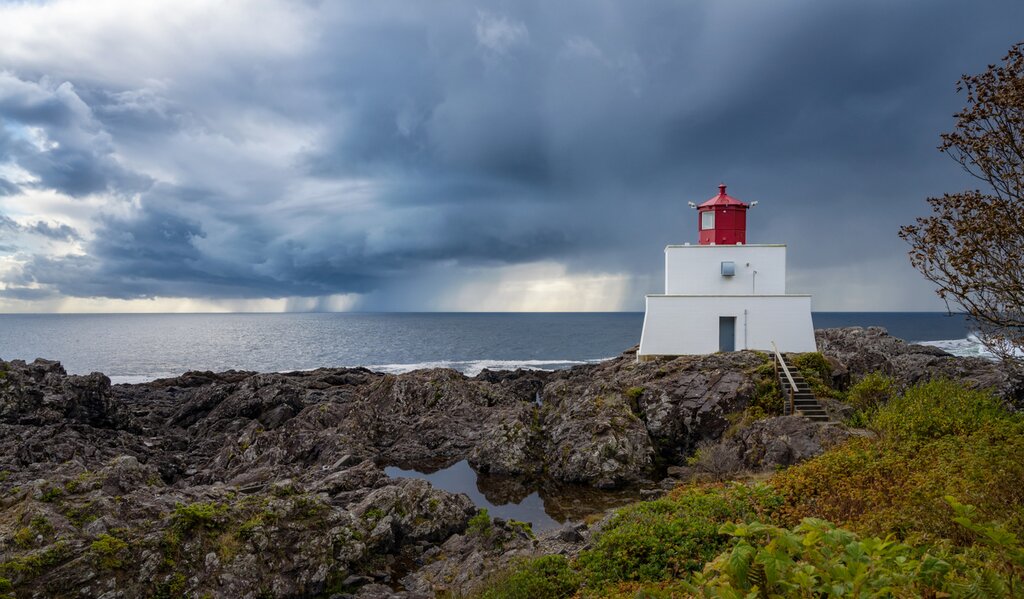Weather
March is the start of spring in British Columbia, but you'd only know it in some parts of the enormous province. There's a lot of variation in climate from north to south and from the coast to mountains: northern, inland, and mountainous areas are typically colder than the wetter coastal ones. March in British Columbia ranges from mild and damp on the southern coast, with thawing snow and the resulting meltwater, to cold and wintry in the north and mountainous. Whatever the temperature, though, the days are noticeably longer throughout the province this month.
Vancouver, on the southwestern coast, tends to be mild year-round, including in March, with a minimum temperature of 39°F (4°C) and a maximum of 50°F (10°C). Inland areas are colder in winter and warmer in summer than the coast, and March is an in-between month. For example, Kelowna, in inland southern British Columbia, has a minimum of 32°F (0°C) and a maximum of 50°F (10°C). Meanwhile, northern parts of the province remain cold and wintry in March; for example, Fort Nelson, in the province's northeast and at roughly the same latitude as Juneau, Alaska, has a minimum of 10°F (-12°C) and a maximum of 30°F (-1°C).
Crowds & Costs
March is still peak season for skiing and other snow sports in resort towns in the mountains of southern and southeastern British Columbia, particularly the Rocky Mountains and Kootenay Rockies and the Vancouver area. In popular resorts—Whistler, Revelstoke, and Kicking Horse—it's essential to book accommodation in advance, especially if you're traveling at the weekend or around Easter (if Easter falls in March).
Beyond popular mountain resorts, now is the low season for travel elsewhere in British Columbia. As a big city with a milder climate, Vancouver will have a few visitors, and you may find a low-season deal on accommodation. Smaller towns inland and up the coast may have limited off-season facilities.
Where to Go
Coastal British Columbia is a great place to visit in March as the climate is milder than in other areas. Get outdoors now that the days are lengthening, and enjoy some of the forests and other natural landscapes the province is known for without getting too cold. Wildlife enthusiasts should head to the Great Bear Rainforest, the largest coastal temperate rainforest in the world, northwest of Vancouver. The enormous moss-covered pine forest is home to trees that are up to 1,000 years old and, true to its name, bears (including the elusive white bear). Bella Coola is a good base for exploring, with facilities and tours into the rainforest, including cozy lodges.
The Vancouver area is a good choice for early spring travel in British Columbia because although the weather can be changeable, there are a variety of indoor and outdoor attractions to take advantage of, whatever the weather. The climate is mild so you can get around the city, between museums and restaurants, in relative comfort. Alternately, head east of Vancouver to Harrison Hot Springs for a relaxing getaway from the city that doesn't involve snow sports. The village is attractively located on Harrison Lake, and guests of the resort can use the onsite hot mineral springs.
Chat with a local specialist who can help organize your trip.
What to Do
The Pacific Rim Whale Festival in Tofino from mid-March to early April coincides with the northward migration of more than 20,000 gray whales along the western coast of Vancouver Island. The whales feed in the shallow waters, making them relatively easy to observe from shore or open ocean boat tours from Tofino or Ucluelet. As well as whale watching, festival attendees can see programs and talks by ocean scientists, researchers, and conservationists.
In March, the ski season is still in full swing in British Columbia, and outdoor enthusiasts will want to make the most of the offerings before the weather warms up. With several top ski resorts near Vancouver, plan to spend a few days in the city before heading to the mountains. Destinations like Whistler, Grouse Mountain, Cypress Mountain, and Squamish offer excellent skiing, snowboarding, and snowshoeing adventures.
Events in March
Pacific Rim Whale Festival, Tofino. Watch the whale migration and listen to talks from scientists and specialists during this festival on Vancouver Island from mid-March to early April.
Easter, nationwide. Good Friday and Easter Sunday are public holidays throughout Canada, so expect business closures. While Easter Monday isn't an official holiday, many people take this day off, and businesses remain closed. Easter can fall in March or April.
Victoria Beer Week, Victoria. British Columbia is well known for its tasty and varied array of local microbrews, so this festival in the quaint town of Victoria is a fun way to sample the offerings of more than 50 British Columbia craft brewers.
Traveling to British Columbia in March? Check out this great itinerary
Pacific Rim Adventure: Vancouver to Tofino Road Trip - 6 Days. This road trip from and to Vancouver takes you to the rugged coastline of Pacific Rim National Park. Overnight in a wilderness lodge or cozy B&B along the coast and spend three days exploring the beaches and rainforest around Tofino and Ucluelet as well as the remote islands of Clayoquot Sound.
More Helpful Information
British Columbia in February
British Columbia in April
Best Time to Visit British Columbia
How Many Days to Spend in British Columbia
